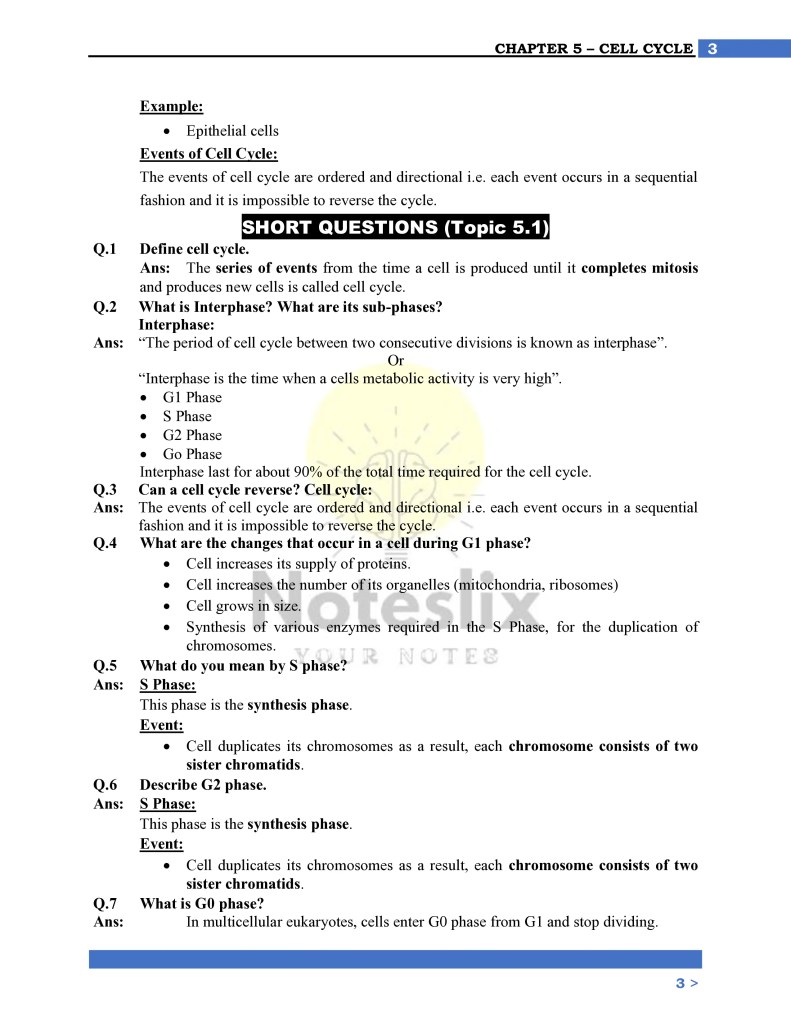Biology is a fascinating subject that helps students understand the intricacies of life. Chapter 5 of the Class 9th Biology syllabus delves into the Cell Cycle, a fundamental concept explaining the processes of growth, division, and replication in cells.
To make this topic easier for students, we have compiled comprehensive notes, including MCQs, short questions, long answers, and diagrams. These solved notes ensure clarity and accuracy, empowering students to excel in exams.




























Topics Covered in These Notes
The notes encompass the following sections from Chapter 5:
- Cell Cycle
- Definition
- Major Phases (Interphase and Mitotic Phase)
- Events during G1, S, and G2 phases
- Characteristics of the G0 phase
- Importance of Interphase
- Mitosis
- Definition
- Discovery
- Phases of Mitosis (Prophase, Metaphase, Anaphase, Telophase)
- Cytokinesis in animal and plant cells
- Significance of Mitosis
- Common Questions and Answers
- Short definitions (e.g., Interphase, G0 phase, Kinetochore)
- Differences (e.g., mitosis vs. binary fission)
- MCQs to test key concepts
- Additional Topics
- Errors in the Cell Cycle and their outcomes
- Tumors (benign vs. malignant)
- Importance of cell cycle regulation
These notes are structured to help students comprehend and retain the concepts effectively.
Class 9th Biology Chapter 5 Solved Notes Topic Wise
1. Multiple Choice Questions (MCQs)
The MCQs are designed to test foundational knowledge and prepare students for competitive exams. Here are a few examples from the notes:
- The phase in which a cell duplicates its chromosomes is:
- A) G1 Phase
- B) S Phase
- C) G2 Phase
- D) M Phase
Answer: B) S Phase
- Which phase of mitosis involves the separation of sister chromatids?
- A) Prophase
- B) Metaphase
- C) Anaphase
- D) Telophase
Answer: C) Anaphase
2. Short Questions
- Q: Define the Cell Cycle.
A: The series of events from the time a cell is produced until it completes mitosis and forms new cells is called the cell cycle. - Q: What happens during the G1 phase?
A: The cell grows in size, increases its protein supply, and synthesizes enzymes needed for chromosome duplication in the S phase.
3. Long Questions
These notes provide detailed answers to complex questions, such as:
- Explain the events of the cell cycle in detail.
The explanation is broken down into phases, highlighting key processes like protein synthesis, chromosome duplication, and spindle fiber formation.
4. Diagrams and Tables
Visual aids like diagrams of the cell cycle, mitotic stages, and cytokinesis in plant and animal cells make these notes engaging and easy to understand.
Tool for Success in Exams
These notes act as a reliable tool for students preparing for exams. The concise yet detailed explanations of key topics ensure clarity, while the solved MCQs and questions provide ample practice to reinforce learning. Additionally, diagrams and tabular data enhance the retention of complex processes.
Colored Notes
Visual learners often benefit from colorful and well-structured notes. These notes include vibrant diagrams, flowcharts, and labeled illustrations that simplify the concepts of the Cell Cycle and Mitosis. For instance:
- Cell Cycle Stages: Illustrated with a circular diagram showcasing G1, S, G2, and M phases.
- Mitosis Phases: Each stage (Prophase, Metaphase, Anaphase, Telophase) is depicted with clear diagrams, highlighting key events like chromatin condensation, spindle fiber formation, and chromosome separation.
By integrating color coding, these notes help students differentiate between stages and retain information effortlessly.
Notes Are Free to Use
A significant advantage of these notes is their accessibility. Students can download and use them free of cost, making them an excellent resource for exam preparation. Whether it’s for quick revision or in-depth study, these notes cater to all learning needs without adding any financial burden.
Notes Are Mistake-Free
Accuracy is paramount in academic resources. These notes have been meticulously prepared and thoroughly reviewed to ensure they are error-free.
Every answer, diagram, and explanation aligns with the prescribed syllabus, ensuring students receive reliable information. The inclusion of solved exercises further guarantees that students are well-prepared for exams.
Conclusion
Chapter 5, focusing on the Cell Cycle, is a vital part of the Class 9th Biology curriculum. These solved notes, enriched with MCQs, short and long questions, and visually appealing diagrams, provide a comprehensive guide for students.
By emphasizing clarity and precision, these notes serve as an indispensable resource for mastering complex topics. Students can confidently rely on these notes to ace their exams and build a strong foundation for advanced studies.
Other Class 9th Biology Solved Notes Topic Wise
- Class 9th Biology Chapter 1 Solved Notes Topic Wise
- Class 9th Biology Chapter 2 Solved Notes Topic Wise
- Class 9th Biology Chapter 3 Solved Notes Topic Wise
- Class 9th Biology Chapter 4 Solved Notes Topic Wise
- Class 9th Biology Chapter 6 Solved Notes Topic Wise
- Class 9th Biology Chapter 7 Solved Notes Topic Wise
- Class 9th Biology Chapter 8 Solved Notes Topic Wise
- Class 9th Biology Chapter 9 Solved Notes Topic Wise

